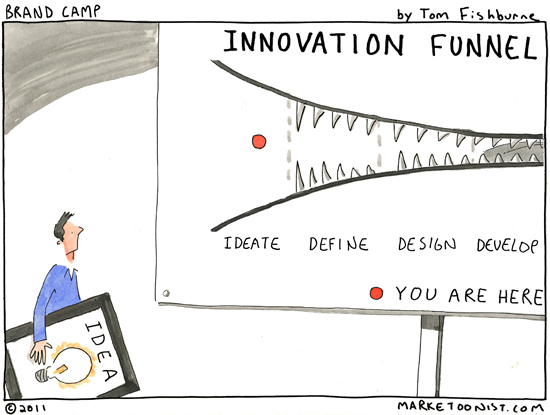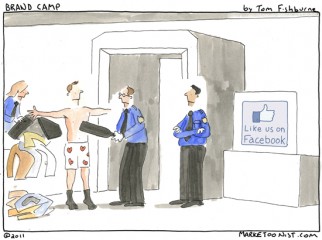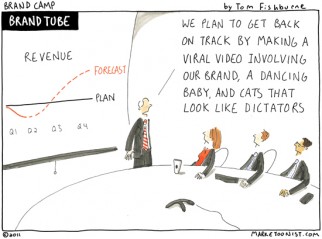Every company has some form of innovation funnel. The funnel is wide at the front to capture potential ideas and narrows to the select few that launch. Projects progress from the idea stage through design and ultimately to market.
Amazingly, the average new product success rate is less than 10%. So companies spend a lot of time on this innovation funnel looking for ways to boost their hit rate. Most companies focus on the back end. They raise the bar, elevate the hurdles, and tighten the scrutiny, allowing fewer ideas to make it through. They inject more idea killers and sharp teeth into the process.
Yet running a more severe gauntlet doesn’t necessarily lead to better ideas. It can lead to safer ideas, but the added internal review cycles and scrutiny sometimes sand away what makes ideas most unique.
Funnel focus is better placed on the front end. Ensure a heavier and constant stream of new ideas and then find ways to test versions of those ideas in the market. Learn from actual use of the ideas and spend less time in stage gates.
LinkedIn founder Reid Hoffman shared some entrepreneurial observations recently, including this gem on innovation:
“Launch early. Unless you’re Steve Jobs, you’re most likely partially wrong about what your theory was. So launch early and often. Launching early attracts customer engagement, and it’s the customer who’s going to tell you what’s wrong so you can correct it.”
I think this iterative approach can apply to physical products, not just web products. Betabrand in San Francisco launches a new idea each and every week. Some do well and some don’t, but they learn with small stakes. Small stakes allow them to place frequent bets.
Rather than try to lower the failure rate, lower the cost of failure.



Alex Vidal says
Awesome. This post reminds me of two of my favorite Michael Jordan quotes:
“I’ve missed more than 9000 shots in my career. I’ve lost almost 300 games. 26 times, I’ve been trusted to take the game winning shot and missed. I’ve failed over and over and over again in my life. And that is why I succeed.”
“You miss 100% of the shots you don’t take.”
Steve says
In this tough economy, sr. mgmt seems to be looking for the ‘home run’ product that will turn things around for us instantly. They suggest challenges and hurdles (teeth) that cause us to go back to the ideas, refine & refine until we don’t have anything to offer. The bar is very high for NPD and our desire for success is higher. We need to continue to introduce the ‘single and doubles’ as we work towards finding and refining that ‘home run’ idea. It’s there, they just don’t come as frequent as some execs would want.
Carola says
The innovation funnel is a funny animal. You need to feed it well and often, as it has a habit of being very selective and picky when it comes to its tastes and unfortunately will throw up most of the food you give it. To keep it alive you need to keep feeding it.
There’s no use in taking it to the dentist: processes and protocols (the teeth) are necessary to keep the ‘digestive system’ in order. As ideas will have to thrive within the corporate environment in order to be launched succesfully.
Leadhead.com says
Let’s not forget that so many of the stage gates and hurdles involve consumers, and while the consumer may be king, consumers do not innovate! Consumers speak very well to their dreams, wishes, challenges and points of pain, but they cannot forsee that which does not exist today. Too often they do not even react realistically to a breakthrough innovation until it is actually in the marketplace where factors like using it out in the real world and seeing others use it comes into play.
Eileen says
I wish everyone had this point of view. I totally agree. I have this quote up on the wall of my office to remind me:
“Try Again. Fail again. Fail better.” — Samuel Beckett
CHRIS says
This idea flies in the face of large corporations who spend years developing a product and spend to ensure it lasts long enough for the consumer not to notice it was a failure. Failing fast is also hard without the right Retailer engagement and support. They need to know that they are part of the process and that not everything will be perfect. If they don’t, then the company is at risk for producing a less than perfect product and gets dinged on the performance of their portfolio. Most companies aren’t willing to take that risk. Are there any retailers that have embraced their role in this process?
Leah G says
I’m thinking the blender comes next, where ideas are then turned into single color mush!
Kim L. says
Clearly the next step in this process, as you have so humorously depict, is to devour all creativity.
Mark Moreno says
Regrettably, people and companies often spend time, resources, and energy trying to produce the next category killer while neglecting some really good cash cows that merely need some tweaking. To many great products and services seem to get neglected in pursuit of the next new wonder widget.
tomfishburne says
Hi Leah, I actually used the blender once — as an image turning ideas to mush, in one of my earliest cartoons: https://marketoonist.com/2002/11/lifecycle-of-innovation.html
Alex Vidal says
In response to the Leadhead.com commenter… great point! I believe we are experiencing a lot of that right now with the new “Color” app… anyone?
H. Chimoff says
More in-market testing and less gate documents is a good idea. So much internal time and so many resources are consumed during the funnel proceess, often without actual, live input from consumers and customers. Launching is expensive, though. That’s where the iterative approach makes sense. Find economical ways to introduce/test and then optimize concepts and ideas. If one looks like a winner, increase the resource committment and determine if you’ll have a winner.
Philip says
Instead of well meaning ‘devil’s advocates’ who just try to dismember ideas, we need more ‘success advocates’ so that ideas are nourished and can grow from unrefined hunches into refined successes. Next time somebody says “Let me play devil’s advocate here…” interject “Great idea, but let’s put a spin on it and leverage your insight and expertise to think about how this can work not why it can’t”.
Imagine a devil’s advocate raising a child: “Ugh, can’t run away from threats, doesn’t contribute to tribe, can’t speak, can’t feed itself. Probably better to kill it off”.
@ Steve, say hello to Cathy:)
Linda says
This is exactly the message I needed today. In my firm, ideas are so often chewed up and spit out due to cost concerns that we are constantly trying to either innovate under the radar (asking for forgiveness rather than permission) or expending huge amounts of energy and resources finding ways to execute our ideas on a shoestring budget (penny wise and pound foolish). Thanks for capturing my angst in a single cartoon!
Priz says
Leadhead.com hits the nail on the head “consumers do not innovate”. It is all about consumers but it is hard for them to comment on revolutionary things that haven’t existed before. Once they’ve experienced and “get it” then they have ownership and are great at commenting on and improving things.
tomfishburne says
Hi all,
Many thanks to everyone for the great dialog and insights! I’m working on a cartoon book on innovation and you’ve all given me great food for thought.
This week’s “Marketoonist Monday” winner is Wendi at Leadhead.com. I love the insight that “consumers do not innovate” (that would make a good cartoon it itself actually). A signed print of this week’s “Innovation Funnel” cartoon is on the way.
I plan to do it again next week. All the best!
-Tom
David B says
A great example of snatching defeat from the jaws of victory.
Kristina from XIAMETER.com says
This made me chuckle, it’s definitely true. I wonder though if this could be applied to business model innovation as well and not just products? Our story here at XIAMETER involves innovation through a new customer experience and our customers, once they tested the waters and changed habits, responded positively to the changes.
Leadhead makes a good point, consumers don’t innovate. In most cases, they don’t even know that a need exists until it’s given to them through a new value prop or product.
Looking forward to your book Tom!
Anna Lyndon says
Think i might be a little late to the party on this thread but figured i’d forge ahead and offer up some thoughts. For me a funnel is completely the wrong shape to represent the most effective innovation process. If your start point is simply a whole raft of ideas then no wonder its so difficult to find a ‘wonder widget’, the analogy of ‘throwing lots of +*&^ at the wall and seeing what sticks’ springs to mind….Surely the funnel is actually a diamond? where you initially focus efforts on identifying the strategic innovation opportunity? idenitfying where the money could come from? and then using creativity to solve or take advantage of a specific opportunity?
Jac says
Great discussion; one of my key takeaways is that we need a funnel (or a stage gating process) that looks at value creation first (initially) and at risk reduction later on.
http://flightmap.wordpress.com/2011/12/29/treat-early-and-late-gates-in-the-innovation-funnel-differently/